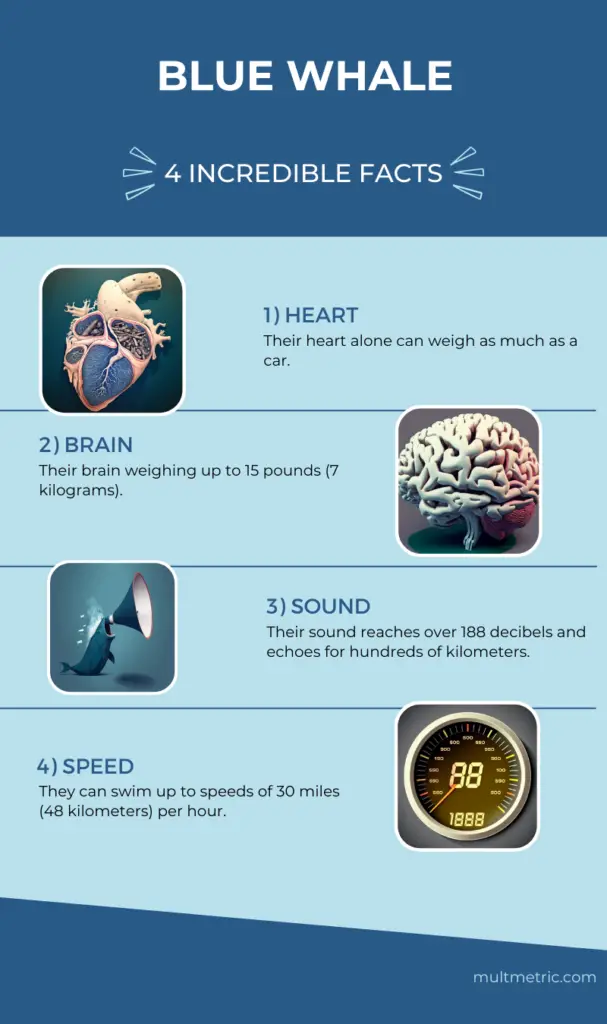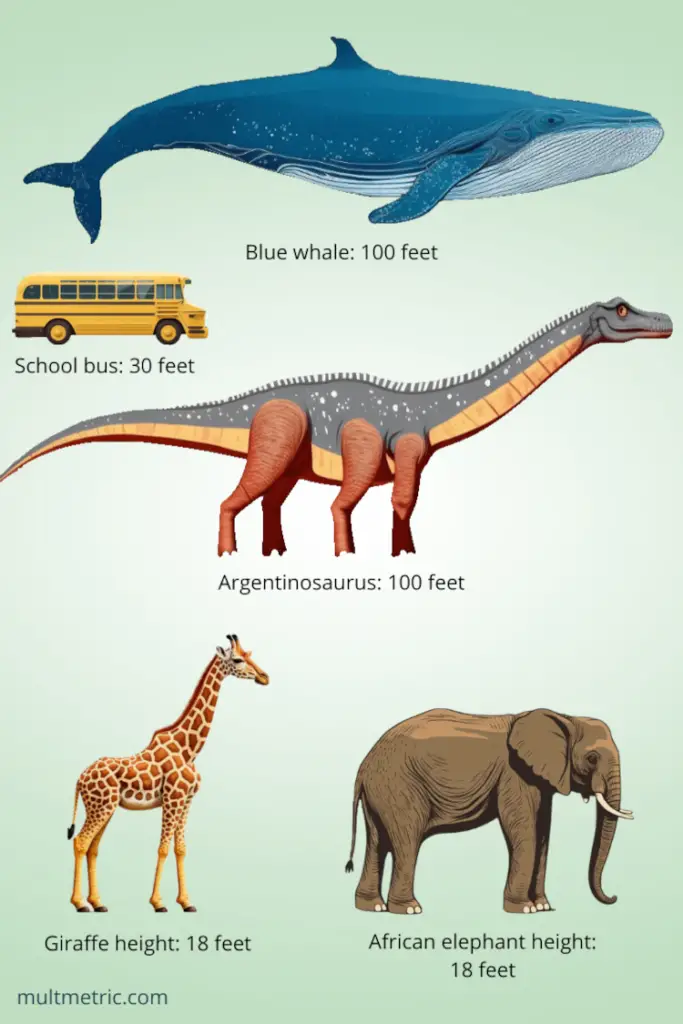The blue whale, scientifically known as Balaenoptera musculus, is the largest animal species on the planet. These organisms possess a remarkable size that is truly extraordinary. Blue whales can reach a maximum length of 100 feet, and their body mass can reach up to 200 tons.
To understand the significance of these organisms within the natural world and to promote conservation efforts, it is crucial to appreciate their size. This article aims to explore the comparative size of blue whales with other whale species, other large animals, and within a historical context. Furthermore, this article will examine geographical variations and changes throughout the blue whale’s life cycle.

Comparison tool
Click “Add person” -> “select object”. It’s name and height will be substituted in the addition form. Then you can change the color of the object.
Average size of blue whales
- The average length of blue whales ranges between 80-100 feet.
- The record length for this species is believed to be 110 feet.
- The average weight of blue whales is approximately 200 tons, with the heaviest blue whale on record weighing 330 tons.
Interesting Facts About the Size of Blue Whales

Blue whales, the largest creatures on Earth, possess unique and fascinating physical attributes that distinguish them from other species.
- These majestic marine mammals have a heart so massive that its weight is equivalent to multiple human adults combined.
- Similarly, the weight of their enormous tongue can be likened to that of a small car.
- Apart from their size, blue whales also have the largest brains of any animal on Earth, weighing up to 15 pounds (7 kilograms).
- Their circulatory system is also impressive, as their heart can pump over 330 gallons (1,250 liters) of blood with each beat, and their arteries are large enough for a person to crawl through.
- One of the most notable features of blue whales is their massive mouth, which can engulf up to 90 tons (81 metric tons) of water along with small fish and krill.
- Despite their bulk, blue whales are remarkably agile swimmers, able to reach speeds of up to 30 miles (48 kilometers) per hour.
- In addition to their physical attributes, blue whales are known for their distinctive vocalizations, which are the loudest animal sounds on earth. These calls can be heard for hundreds of miles across the ocean, and it has been suggested that they serve as a means of communication between the whales over long distances.
- Blue whales consume up to 4 tons (3.6 metric tons) of food per day, mainly consisting of tiny krill.
- Blue whale calves are born at a size of up to 25 feet (7.6 meters) and can gain up to 200 pounds (91 kilograms) per day during their first year of life.
- Finally, blue whales are among the longest-living mammals, with a lifespan of up to 100 years or more.
Preserving these magnificent creatures and studying their unique characteristics is crucial for future generations to appreciate and admire.
Compared to others

Here is a table comparing the size and weight of some largest animals and items:
| Animal/Item | Size (feet/meters) | Weight (tons/metric tons) |
|---|---|---|
| Blue Whale | Up to 100 feet/30 meters | Over 200 tons/180 metric tons |
| African Elephant | Height up to 13 feet/4 meters | Up to 7.5 tons/6.8 metric tons |
| Humpback Whale | Up to 60 feet/18 meters | Up to 40 tons/36 metric tons |
| Saltwater Crocodile | Up to 23 feet/7 meters | Up to 1.2 tons/1.1 metric tons |
| Giraffe | Height up to 18 feet/5.5 meters | Up to 2.1 tons/1.9 metric tons |
| Brown Bear | Up to 9 feet/2.7 meters | Up to 0.8 tons/0.7 metric tons |
| Whale Shark | Up to 40 feet/12 meters | Up to 15 tons/14 metric tons |
| Megalodon | Up to 60 feet/18 meters | Up to 55 tons/50 metric tons |
| Largest Dinosaur (Argentinosaurus) | Up to 100 feet/30 meters | Up to 90 tons/82 metric tons |
| School Bus | About 30 feet/9.1 meters | About 10 tons/9 metric tons |
| Cruise Ship (Harmony of the Seas) | Up to 236 feet/72 meters | Up to 228,000 tons/207,000 metric tons |
| Titanic | Up to 175 feet/53 meters | Up to 52,310 tons/47,500 metric tons |
| Football Field | 360 feet/110 meters | N/A |
| Small Boat (Fishing Vessel) | Up to 50 feet/15 meters | Up to 40 tons/36 metric tons |
When comparing the animals, it’s important to note that their sizes and weights can vary significantly based on a number of factors. This table provides a rough comparison of the height and weight of some of the largest animals. It’s worth noting that animals like African Elephants and Brown Bears can have a range of sizes and weights within their species.

Comparison to other whales
- When it comes to whales, Blue Whales are considerably larger than Sperm Whales, measuring up to around 100 feet in length and weighing approximately 200 tons.
- Humpback Whales are also smaller, with an average length of around 50-60 feet and weight of around 40 tons.
- Orcas and Minke Whales are much smaller still, with lengths of around 20-30 feet and weights of around 5-10 tons.
Comparison to other large animals
- Compared to land animals, Blue Whales are truly massive.
- While Elephants are the largest land animals, they still pale in comparison to Blue Whales, with an average length of around 10-13 feet and weight of around 5-14 tons.
- Giraffes, the tallest land animals, are also considerably smaller than Blue Whales, with an average length of around 14-18 feet and weight of around 1-1.9 tons.
Historical context
- Blue whales are one of the largest creatures to have ever existed on Earth.
- While the Argentinosaurus and the Blue Whale are thought to have weighed approximately 90 tons and 200 tons respectively, the sheer size of blue whales is still awe-inspiring.
- Accounts of blue whales measuring around 80-90 feet in length date back to the early 20th century, highlighting their impressive size throughout history.
Geographical variation
Blue whale populations around the world display geographical variation in size, with some groups being smaller or larger than others.
A variety of factors can explain these differences, such as variances in food availability and genetic factors.
Food availability and genetics are both factors that influence the size of blue whale populations. For instance, colder waters with a higher abundance of food are linked to larger blue whale populations. In contrast, warmer waters with less food are associated with smaller blue whale populations.
Changes throughout life cycle
Throughout their lifetime, blue whales continue to grow, with lengths and weights increasing. However, as they age, blue whales eventually reach a maximum size before they start to shrink. This phenomenon can be attributed to food availability, genetics, and other environmental factors.
Conclusion
Overall, blue whales are fascinating creatures that are difficult to fathom in their enormity. By comparing their size to other whales, large animals, and historical context, we gain a better understanding of their place in the natural world. Visual aids such as images and graphs are essential for appreciating their size, and it is vital to continue studying and protecting them for future generations to enjoy.

It iiiiiiiiis gooooooood!
I would like you to place the human figure without the option to change color. As in the figure comparing the blue whale and the human. I think that way it would be better to compare heights.
they should add Cthulhu